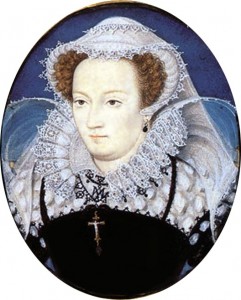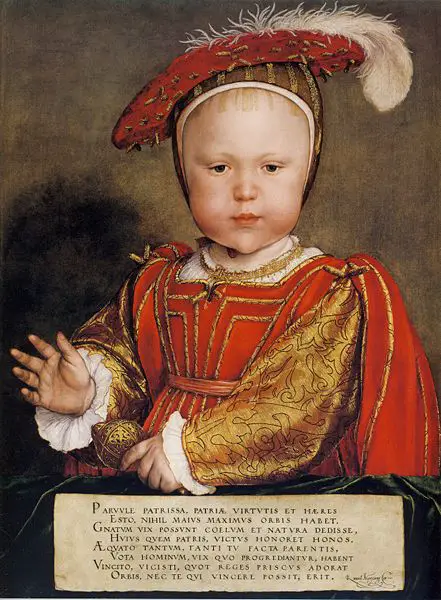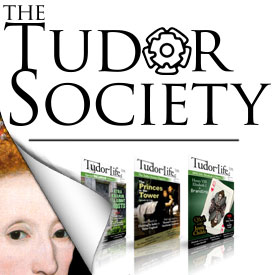On this day in history, 14th October 1586, the trial of Mary, Queen of Scots, began at Fotheringhay Castle in Northamptonshire. Historian John Guy, author of My Heart is My Own: The Life of Mary Queen of Scots, has written a brilliant chapter on Mary's downfall, "Nemesis", and I have him to thank for the information in this article.
Mary Queen of Scots had, at first, refused to appear before Elizabeth I's commission, but had been told by William Cecil that the trial would take place with or without her. She appeared in front of the commission at 9am, dressed in a black velvet gown and a white cambric cap and veil. Mary then protested against the commission, arguing that the court was not legitimate and arguing against the fact that she was not allowed legal defence and was not able to call any witnesses. Mary was also not permitted to examine any of the documents being used against her. Her protests were in vain and the prosecution went ahead and opened the trial with an account of the Babington Plot, arguing that Mary knew of the plot, had given it her approval, agreed with it and had promised to help. Mary protested her innocence:
"Mary: I knew not Babington. I never received any letters from him, nor wrote any to him. I never plotted the destruction of the Queen. If you want to prove it, then produce my letters signed with my own hand.
Counsel: But we have evidence of letters between you and Babington.
Mary: If so, why do you not produce them? I have the right to demand to see the originals and copies side by side. It is quite possible that my ciphers have been tampered with by my enemies. I cannot reply to this accusation without full knowledge. Until then, I must content myself with affirming solemnly that I am not guilty of the crimes imputed to me..."1
Unfortunately for Mary, Elizabeth's spymaster, Sir Francis Walsingham, had collected a great deal of evidence:
- A confession made by Sir Anthony Babington who had also pleaded guilty at his own trial.
- A deciphered transcript in English of Mary's reply to Babington.
- A reciphered copy of Mary's original letter to Babington which looked exactly like the original.
- Confessions from Mary's secretaries.
When the prosecution produced all of this evidence, Mary burst into tears but still denied her involvement, claiming that the documents were counterfeit. Walsingham proclaimed his innocence, stating that the documents were real. A distraught Mary proclaimed that "I would never make shipwreck of my soul by conspiring the destruction of my dearest sister."2 The court was then adjourned for lunch.
After lunch, the secretaries' confessions were read out, much to Mary's shock and horror. Mary argued that her letters must have been tampered with after she had seen them, and then argued:
"The majesty and safety of all princes falleth to the ground if they depend upon the writings and testimony of their secretaries... I am not to be convicted except by mine own word or writing."3
The trial continued the next day with the prosecution accusing Mary of consenting to Elizabeth's assassination in her reply to Babington. Mary tried to argue that although she had written "then shall it be time to set the gentlemen to work taking order upon the accomplishing of their design"4, she had not specified what the "work" was. However, as the prosecution pointed out, Mary had also appealed for foreign help and although she argued that an act of war, even if it resulted in Elizabeth's death, was legitimate if it allowed her, a queen, to be free at last, the commission saw her actions as an act of treason.
As the trial closed, Mary demanded that she should be heard in front of Parliament or the Queen, but she was fighting a losing battle. Sentence was delayed as long as possible, by order of Elizabeth, but on the 25th October the commission reconvened and found Mary guilty.
On the 29th October, Parliament met to discuss Mary Queen of Scots, the Babington Plot and her role in Lord Darnley's murder, and it was decided that they should petition Elizabeth to execute Mary. This put Elizabeth in a difficult position as she did not want to be accused of regicide.
On the 4th December, Mary was publicly proclaimed guilty and finally, on the 1st February 1587, Elizabeth called her secretary, William Davison, asking him to bring Mary's execution warrant to her to sign. Elizabeth signed it but told Davison to ask Walsingham to write to Sir Amyas Paulet, in his own name, asking him to kill Mary. This would enable Elizabeth to be rid of her nemesis without taking any responsibility for it, instead Paulet would be acting privately under the Bond of Association.5 Paulet was understandably horrified, protesting that "God forbid that I should make so foul a shipwreck of my conscience."6 Meanwhile, Sir William Cecil called a secret meeting of Elizabeth's Privy Council which agreed to send the signed warrant to Fotheringhay. Cecil appointed the Earls of Shrewsbury and Kent to direct the execution and the council agreed to keep Elizabeth in the dark until the deed was done.
On the 8th February 1587 Mary Queen of Scots was executed at Fotheringhay Castle. Although Elizabeth was furious with her Council, so much so that Cecil fled to his home and Davison was thrown into the Tower, John Guy points out that whatever happened to Mary, whether she was assassinated or executed, Elizabeth could deny any responsibility:
"She had carefully contrived things so that she would win whatever happened. If Mary was killed under the Bond of Association, Elizabeth could disclaim responsibility. If Cecil covertly sealed the warrant and sent it to Fotheringhay behind her back, she could claim she had been the victim of a court conspiracy."7
Clever.
Learn more
If you want to learn more about Mary and all things Tudor, try our 14 day free trial.
Notes and Sources
- My Heart is My Own: The Life of Mary Queen of Scots, John Guy, p490.
- Ibid., p492
- Ibid.
- Ibid., p483
- The Bond of Association - p474 John Guy describes the Bond of Association as "a licence to kill". Anyone signing the Bond, which was drawn up by Cecil and Walsingham in 1584 after the 1583 Throckmorton plot, was swearing to "pursue as well by force of arms as by all other means of revenge" anyone plotting to cause harm to the Queen.
- Ibid., p496
- Ibid., p497
Top image: Drawing of the trial of Mary, Queen of Scots, 14–15 October 1586. Image taken from Papers and correspondence relating to Mary, Queen of Scots. Originally published/produced in England; 1586
Further Reading
- State trials of Mary, Queen of Scots, Sir Walter Raleigh, and Captain William Kidd, Condensed and copied from the state trials of Francis Hargrave, esq., London, 1776, and of T. B. Howell, London, 1816, with explanatory notes, p1-57
Posted originally on The Elizabeth Files in 2010.





It is known that Queen Elizabeth Struggled alot before killing her. I wonder if it was becouse she did not want to be percieved as blood thirsty?
I really don’t think Elizabeth “wanted” to kill Mary. I believe it was something that laid heavily on her heart the rest of her days.
England was so lucky to have had Elizabeth.
Not true, she was jus worried about killing a fellow Queen and how history would portray her
She didn’t Jean, she procrastinated for almost 20 years before agreeing to that Mary was a threat to England.
Elizabeth signed the warrant of execution, but I believe gave no order for it to be dispatched or carried out.
I agree totally about Elizabeth being tormented by Mary’s death for the rest of her life, and I also believe that by accepting Mary’s son James (although she never actually said so in so many words) as her heir, it was Elizabeth’s way of atoning for that sin.
If you look at the way Henry’s will was drafted next in line on the English throne would have been the Grey sisters and their children. Henry completely disregarded the Scottish line via his older sister Margaret, due to her scandleless behaviour.
Everyone knows that Walsingham was the mastermind behind the correspondence alleged to be between the six gentlemen including Anthony Babington by running the means of communication. The letters were smuggled in and out of the castle by barrels and Walsingham arranged this. His spy ring controlled everything. This is how the letters came into his procession. For months letters went back and forth, the parties using code within codes, some of the most complex cythers ever used. Identities were concealed and words used to conceal any indication of a plot. Mary was right, she had not consented to anything….the words simply wish the six gentlemen well in their enterprise. For weeks Babington merely expressed admiration for Mary, Francis Walsingham was frustrated as he could find nothing and he began to interfere with her letters, adding his own stuff, giving false hope and information to Mary and encouraging Babington by adding to Mary’s letters. He was setting a trap and modern historians agree that Walsingham arranged for the information to be sent on and added to the original letters. It is not absolutely clear what was added but Mary made this accusation at her trial and was denied the right to see the evidence against her. Mary also denied that she had consented to the plot to kill Elizabeth and some people think that she merely consented to the plan to rescue her. Now this is were it all gets merky and historians have debated just as to her intent for years. As the evidence was tampered with in order to draw Mary into consenting to Babington this is still something that cannot be confirmed for certain. Babington was a young idealist revolutionary who was obsessed with Mary, in love with her, as in devoted to her. Mary was desperate for freedom and had long given up on being Queen, but hoped her son would now succeed. This did not stop idealistic people wanting to replace the illegitimate, heretical Elizabeth I with, as they saw it, the legitimate, Catholic Mary. Support for such a venture to succeed would have to come from Spain and lets face it, Elizabeth had consented to piracy which had attacked Spanish ships, goods and territories, thus angering the Spanish King Phillip II. Mary did receive the ambassadors and letters of support for her over the years and Walsingham argued that recent letters found in her apartments from abroad proved that she agreed to the replacement of Elizabeth I and invasion. However, with the tensions between Spain growing, a growing support for invasion abroad and discontent at home, people who were passionate about the idea of having a Catholic Queen to replace Elizabeth getting encouragement, it was only a matter of time before an invasion attempt to achieve all of these things came about, whether Mary consented or not. The ones who wished to kill Elizabeth I were in the minority but Mary Queen of Scots had been a prisoner of her cousin for over 20 years, so she was desperate and would believe anything that could help her be free, even if it was far fetched. Walsingham had failed to be on the nail with the Throgmorton Plot and one of his relatives was involved in an attempt to kill Elizabeth. He did not want to fail again so he took extra care this time, he waited until the letters contained just enough evidence, with agreement for the go ahead. He broke the code and used replacement codes, thus framing both sides into what we may call self recrimination. Walsingham arranged the whole communication between both sides, doctored the evidence and lied to ensure that Mary was tried and executed. Elizabeth I did not put of killing Mary out of concern but because she was afraid. Her cousin was a Sovereign and if she executed a fellow Queen it gave license for her people to kill her if a revolution succeeded. Elizabeth I created her own problems by holding Mary as a prisoner in England in the first place; she was responsible for the current situation. She could not simply execute her, when the entire problem was partly of her own making. Mary may or may not have been in agreement with those who wanted to dethrone Elizabeth, but who held her captive in the first place? Personally I don’t believe that Mary intended to kill Elizabeth, she was just desperate for her freedom. As for Babington well he was obsessed and an extremist, he was a self appointed martyr. His confession reflects this. Mary at the end used this for her own right to the crown of a Catholic martyr, the scarlet gown she wore at her execution is a symbol of grace and martyrdom. Mary was dramatic to the end. Elizabeth I would be condemned by historians and contemporaries for the execution of Mary Queen of Scots, who was seen as a tragic heroine. Whether Elizabeth I wanted to execute her or not, Walsingham and Cecil made sure that she had no choice. Elizabeth was haunted by this decision and like her father, blamed everyone else for her own actions. Elizabeth I signed the death warrant and said that she did not want to carry out the execution. Well tough, she had her own mind, she should never have signed it and pardoned Mary, if not she has to be held responsible; she was the Queen, not her council and history saw that she was.
I think Elizabeth is Wrong and she is the one who has the Spymaster Francis walsinghay with William Davison and Anthony Babington I think that you are wrong and set up for Mary queen of scots and let her free and her freedom Elizabeth kept her prisoner in England many years I think everyone like France and England and Scotland people to rescue Mary Queen of scots In the middle of loch from Loch elven castle and moved another castle and another castle I want her son as the king James the sixth to reunited with his mother and with her relatives of Mary Queen Of Scots so she can be the Queen Of England because she is the longest Clam to the throne of England with her Grandmother Margaret Tudor
As a decendant of both women, mt heart will always lean to Mary.
I always lean towards Mary, but then she is more romantic and tragic than Elizabeth.
May I ask how you are descended from Elizabeth who had no children? Are you descended from one of her cousins or from the family of Anne Boleyn through her sister? Just curious.
Despite the execution of his mother, James V1 was only too happy to accept the English crown when offered it.
Then his son, Charles I, also suffered the same fate!